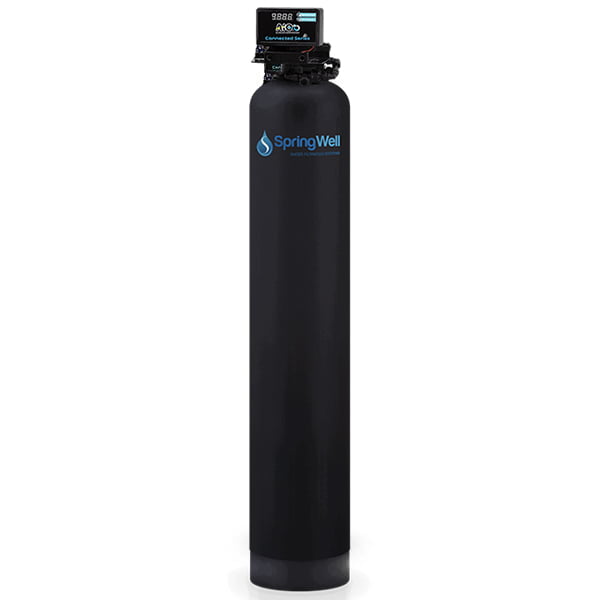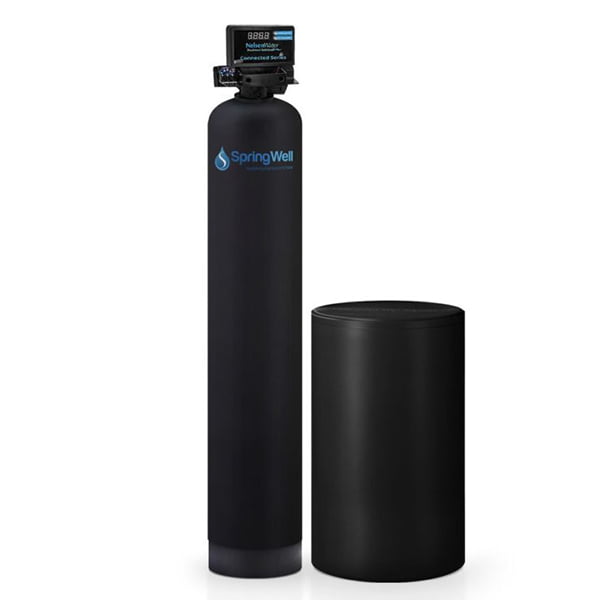How to Remove Iron from Well Water? Best Ways Explained!
Written by: Gene Fitzgerald // Last Updated: Aug 17, 2023
This page may contain affiliate links. If you buy a product or service through such a link we earn a commission at no extra cost to you. Learn more.
Large amounts of iron are a common problem in well water. What you can do about this is remove the iron with the help of a water filter.
Unfortunately, your regular activated carbon-based filter system or even a whole house water filter with several filtration stages may not be able to remove the excess iron from your water. This is when you need special iron filters.
The presence of iron in water doesn’t just cause staining, it can also choke pipes and home appliances over time. Besides, it gives the water a funky taste that just makes drinking unbearable.
So to make water iron-free, this guide will cover various ways to remove the heavy metal, and that too without costing a fortune. Sounds good?
Key Takeaways
- The best way to remove iron from well water will depend on what type of iron exists in your water supply.
- Have your water tested so that you can use the ideal method.
- Ferrous iron – Use a regular iron filter and possibly pre-oxidation.
- Ferric iron – Use mechanical filtration.
- Iron bacteria – Either shock your well regularly and remove bacteria through mechanical filtration or use a chemical injection system + filter.
- Organic iron – Requires chemical oxidation followed by mechanical iron removal.
How Does Iron Enter Well Water?
As mentioned in our guide about the best iron filters for well water in 2024, iron is the most abundantly found metal in the ground.
When rainwater from the surface trickles through the soil and collects in an aquifer or groundwater, it readily absorbs iron on its way. This is because iron is highly soluble.
That’s not all; iron can also end up in your water through industrial waste or corroding pipelines.
Tell-Tale Signs: How to Know If there’s Iron in Your Well Water?
The good thing is that iron contamination is easily detectable even at small levels. Here are the common signs of the presence of iron in your (well) water:
Discoloration
The water may or may not be reddish in color, as the discoloration typically depends on the type of iron. However, one trick to determine the presence of iron through discoloration is to let the water sit for some time. Eventually, any iron will oxidize and give the water a rusty color.
Staining
If red and brownish stains start appearing on your bathroom fixtures like the toilet, bathtub, and sink, that means your water clearly has iron in it. These stains are hard to remove.
Similarly, if you’re washing clothes and doing dishes with iron contaminated well water, you might also see brown and red stains on them.
Metallic Taste and Odor
If the concentration of iron in drinking water is above 0.3 parts per million (ppm) or mg/l, it will give the water a distinct metallic taste and smell. This taste becomes even more prominent when you make coffee or tea.
Unhealthy Skin and Hair
Iron in heavy concentrations in water isn’t just bad for your internal health but also your hair and skin. It may irritate skin and make hair color darker. For instance, it can give blonde hair more of a tinted orange hue.
Moreover, iron can make wrinkles on your skin more apparent. That’s not a good thing for most of us I guess.
Biofilm
If you notice slimy clumps in your water, it’s a sign of iron bacteria. These clumps appear as they break away from the deposits formed by the bacteria in the pipes.
The best way to check if such clumps are forming is to look into your toilet tank. However, they are not always big enough to be seen by the naked eye.
How Can Iron in Water Damage Your Home?
As mentioned above, iron in well water can result in deposits in the entire plumbing system over time. That, in turn, can lead to a gradual decrease in water pressure in faucets and appliances. It may even lead to leakages for which you’ll have to splurge out for expensive repairs.
Another problem is iron bacteria which, as the name suggests, thrives on iron. The presence of this bacteria can worsen any iron situation. The result is more frequent and faster-forming deposits in your plumbing and nasty stains on your clothes, dishes, and fixtures.
In short, a higher amount of iron in well water can wreak havoc in your house.
Testing Water for the Various Types of Iron
Before we get to the various ways of removing iron from water, let’s take a minute to talk about the different types of iron that exist in it. This is important because the type also determines the best filtration technique.
Normally, iron exists in water as ferric iron or ferrous iron. In addition, there can be organic iron and iron bacteria which we’ve mentioned before and that you may also want to test for.
Here is a summary of the different types of iron in water:
- Ferric iron (red-water iron, Fe3+): This type of iron exists in water sources rich with oxygen. As it does not dissolve, it causes the water to turn reddish. Consider it a worst-case scenario as it can easily cause clogging.
- Ferrous iron (clear-water iron, Fe2+): Ferrous iron is found in anaerobic well water (not containing free oxygen). It’s soluble in water, and so it’s not visible. You can’t see it even in tap water.
- Organic iron: This organic matter is a compound of iron. It is more common in shallow wells and those mixed with surface water. It causes the most severe iron staining.
- Iron bacteria: Iron bacteria or bacterial iron is a type of microorganism that feeds on iron. This can make an iron problem much worse. The bacteria typically end up in well water during the construction or repairs of a well. Iron bacteria turn ferrous iron into a slimy film that’s deposits everywhere.
While you’re testing your well water for iron, you may also want to test it for manganese and hydrogen sulfide. Finding out the pH level, temperature, and level of oxygen dissolved also helps you choose the best filter.
Now, how do you go about testing the water? For accurate and fast testing, combine the Essential Well Water Test by Tap Score with the Iron-Related Bacteria Test Kit. These DIY testing kits will test for all of the above forms of iron and give you a clear idea of what you’re dealing with.
Get $10 Off! Use Code: BOS10
How to Remove Iron from Well Water?
Ferrous Iron Filtration
Since ferrous iron is dissolved in water, it requires special filtration. Here are several methods:
Well Water Iron Filter
The most profound method for treating well water with clear-water iron is by using a whole house iron filter. This point-of-entry water filter removes iron giving you safe water in all faucets and water-using appliances.
Such filtration systems can treat well water with iron levels of up to 15 ppm (mg/l). The actual filter media that removes iron may vary by model, with greensand being a common one.
When the ferrous comes in contact with said media, it oxidizes and turns into its ferric form. The ferric precipitates and becomes insoluble, eventually getting trapped in the filter media bed.
What you should know: This type of iron filter system employs backwashing. Otherwise, the filter media becomes saturated after some time. The trapped iron needs to be flushed out and drained through backwashing.
Backwashing is also important to prevent germs from deteriorating the filter.
Moreover, some iron filters recharge their oxidation capacity using a chemical solution.
Air Injection with Iron Filter (Cheapest Method of Eliminating Iron from Well Water)
This method follows pre-oxidation and then filtration to remove iron. The good news, it can remove even higher concentrations, up to a whopping 30 ppm of ferrous and ferric.
Some whole house iron water filters utilize both oxidation and removal in one tank. First, the iron is pre-oxidized from ferrous to ferric using an air pocket in the top. Then, the oxidized particles get trapped in the filter media bed at the bottom.
#1 Whole House Iron Water Filter: SpringWell WS
- Our Go-To Whole House Water Filter for Wells
- Enough Water for Up to 7+ Bathrooms
- Filters Ferrous + Ferric Iron, Manganese, Hydrogen Sulfide
- Can Last 10 or More Years at No Additional Cost
- Maintenance-Free, Backwashes Automatically
- 6-Month Satisfaction Guarantee and Lifetime Warranty (Limited)
- → Detailed SpringWell WS Review
Chemical Oxidizer + Iron Filter
Similar to air injection, iron can also be oxidized using a chemical oxidizing agent. The preferred oxidizers for iron include ozone, chlorine, sodium hypochlorite, hydrogen peroxide, calcium hypochlorite, and potassium permanganate.
First, a pump or injector adds the chemical into the feed water. Then, the water passes through filter media, like greensand.
This treatment method can be used for any level of iron contamination. Also, if your water testing has shown iron bacteria, bleach can be used for both oxidation and as a disinfectant.
The only drawback is that for the oxidization part, the solution of oxidizer and water needs to sit in a retention tank for a while so as to have a long enough contact time. Only then is the oxidation carried out completely.
Furthermore, you may need to filter out chemical byproducts that have resulted from this process. If the chemicals include chlorine, an activated carbon filter can do the job just fine.
Ferric Iron Water Treatment
How can you remove ferric from well water?
Removing ferric iron from well water is relatively easier than ferrous as it’s already oxidized and insoluble. It typically only requires mechanical filtration, such as a sediment filter. Such filters can handle even higher concentrations, say, 10 ppm.
Iron Bacteria Removal
The best way to remove iron bacteria from well water is using shock chlorination and a mechanical filter. Unfortunately, this is required more frequently than you’d think. Just shocking your well once will not do the job.
You’re looking at shocking once or twice every year to keep the growth of bacteria at bay.
An alternate to shock chlorination is chemical injection as described above. Again, with this method you basically inject a bacteria-killing chemical (for example, bleach). In addition, you’ll need a retention tank and filtration stage.
First, the chemical is added into the water. Then, the injected water goes into the retention tank and sits there for a while, allowing the chemical to oxidize the iron and, at the same time, kill the bacteria that feed on it. The iron and the chemical are then removed by the filtration system.
#1 Filter for Iron Bacteria: USWS Matrixx inFusion
- Best for Extremely High Iron Levels + Iron Bacteria
- Enough Water for Up to 7+ Bathrooms
- Filters Ferrous + Ferric, Bacterial Iron, Manganese, Hydrogen Sulfide
- Media Lasts 3-5 Years
- Low Maintenance, Backwashes Automatically
- Lifetime Warranty Tank, 10 Years on Valve, 5 Years on Chemical Injection Panel
- → Read Full Review
Removing Organic Iron
Organic iron, especially colloidal iron, is a pain to remove compared with ferrous and ferric iron. The reason is that iron compounds don’t oxidize so quickly. That’s why a more laborious and customized method is needed.
Typically, you’ll need chemical oxidation followed by mechanical water treatment to get rid of organic iron.
Does a Water Softener Remove Iron?
Good question! An ion exchange water softener can, in fact, remove iron from water. However, it can only deal with ferrous iron up to 3-5 ppm concentration. Water softeners cannot work with ferric iron.
Also, keep in mind that the main purpose of your water softener is removing calcium and magnesium, which cause hardness in water. If the water contains too much iron or has iron other than ferrous, the water softener may not work properly. In fact, its resin may get damaged.
In case you’re relying on your water softener to also remove iron, make sure to keep a regular check on the resin beads. They might need replacement sooner than usual.
Also, program the regen cycles to use higher amounts of salt and set backwashes to run longer. Using a chemical iron remover can also help.
#1 Water Softener for Iron Removal: SpringWell SS
- Our Go-To Water Softener for Tap and Well Water
- Suited for Up to 3 ppm of Ferrous Iron
- Also Removes Up to 1 ppm Manganese and 1 ppm Sulfur
- Enough Water for Up to 7+ Bathrooms
- Highest Salt and Water Regeneration Efficiency
- 6-Month Satisfaction Guarantee and Lifetime Warranty
- → Detailed SpringWell SS Review
When Not to Use an Ion Exchange Water Softener
Avoid using a well water softener if the ferrous iron concentration is above 5 ppm or mg/l. And, you should not use it to treat rust, organic iron, or iron bacteria.
Similarly, also avoid using a softener if the pH of water is too high as it may change ferrous iron into rust too quickly.
Is Iron in Drinking Water Harmful or Is It Safe?
Iron itself is not dangerous for you, as it’s an essential nutrient. However, extremely high amounts of iron can have a negative impact on health. This is because your body can only absorb iron in a limited amount.
Generally speaking, your body can ingest 0.8 mg iron for every kilogram of body weight. In contrast, 200 mg or more for every kilogram of your weight can be extremely hazardous. Now, this is much more than what you’d find in well water, but it’s still worth treating to avoid any complications due to long-term exposure.
How About Iron Bacteria?
While iron bacteria themselves aren’t a health risk, they can give rise to other forms of microbes in the water that can cause diseases.
Frequently Asked Question (FAQ)
- How to remove iron in well water DIY?
You’ll need an iron water filter system or perhaps a water softener (depending on the type of iron and its concentration) to remove iron from well water. However, you can DIY the installation of both. - What is the cheapest way to remove iron in well water?
Air injection paired with an iron filter is the cheapest way of removing iron (ferrous + ferric) from well water. - How to remove iron from water naturally?
If you don’t want to add any chemicals to the water, simply use an iron water filter that utilizes air injection instead of injecting a chemical agent.
If you have any questions about how to remove iron from well water please don’t hesitate to leave a comment below!
Information provided on BOS is for educational purposes only. The products and services we review may not be right for your individual circumstances.
We adhere to strict editorial guidelines. Rest assured, the opinions expressed have not been provided, reviewed, or otherwise endorsed by our partners – they are unbiased, independent, and the author’s alone. Our licensed experts fact-check all content for accuracy. It is accurate as of the date posted and to the best of our knowledge.







